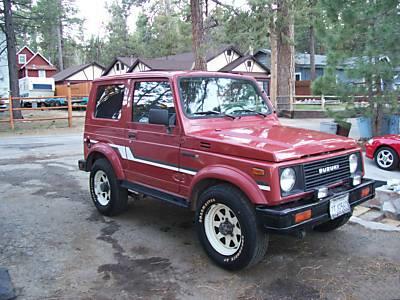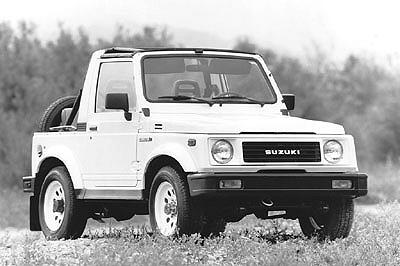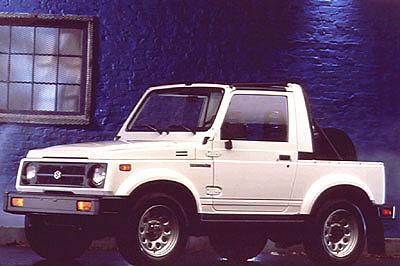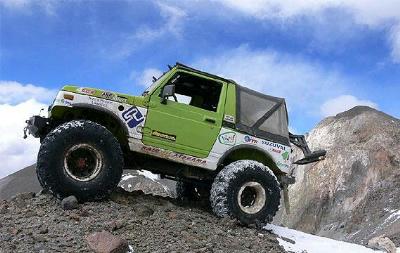1985 was the year that the 1986 model year Samurai was released in America, and it was an instant hit. It started at $6200 and a fully loaded Samurai was $7500. Starting with a mere 1,200 trucks imported per month, sales increased to 8000 vehicles per month and Suzuki quickly found themselves with 47,000 Samurais sold by the end of their first year and 150,000 in three years. Not only was it the top-selling convertible in the United States, but it also captured the best first-year sales record of any Japanese car company.
(1986 Suzuki Samurai – Note the hard top and spoked wheels)
The Samurai had a 1.3 liter, 63 hp, 4-cylinder engine and was available as a convertible or a hardtop. The slow-selling hardtop was dropped after 1989, leaving only the convertible, in a single price level.
The Suzuki Samurai became intensely popular within the serious 4wd community for its extreme off-road performance and reliability compared to other 4wds of the time. It is also considered a great beginner 4wd due to its simple design and ease of modifications with engine swaps and suspension upgrades.
1n 1990, A new 1.3 liter, 66hp, 4-cylinder engine with throttle-body fuel injection was introduced. It only came with a 5-speed manual transmission. An on-demand, part-time 4WD system was standard. Manual-locking front hubs also were standard, but dealers could install automatic-locking hubs.
Year to Year Changes
1988.5 – The 1988.5 model Samurai was re-tuned for better on-road use in the United States. This revision included softer suspension settings and a larger anti-sway bar to reduce body roll. A lower 5th gear (.865:1 vs the earlier .795:1) increased engine rpm and power on the highway. A new aluminum radiator, a redesigned valve cover, and larger transfer case U-joint flanges were used.
On the inside, the dash was totally redesigned from the round air vents to square ones with a better integration of the radio. A 4-spoke steering wheel replaced the previous 3-spoke design. More comfortable seats and rubber shifter knobs were also added. On the outside, new round-hole wheels and a slightly revised radiator grille summed up the visual changes.
1990 – Throttle body fuel injection led the list of changes. Horsepower was increased by only 2 ponies to 66, but improved tractability of the engine improved on and off-road drivability. The engine’s displacement dropped from 1324cc (81 cubic inches) to 1298cc (79 cubic inches). Two of the four spider gears in the front differential were removed, and new sealed transfer case and transmission bearings were installed.
1991 – A pair of two-wheel-drive models arrived for 1991, led by the JA. The JA came without a top or rear seat, while the JS added a folding soft top and 2-place rear seat.
(1991 Suzuki Samurai – Note the convertible and ’round hole’ wheels)
1992 – The 2-wheel-drive JS model dropped out, leaving only the 2WD JA and 4WD JL models.
1993 – The only change consisted of change in a change in the grille design, incorporating the Suzuki “S” in the center of the grille.
(1993 Suzuki Samurai – Not the ‘S’ in the grill instead of ‘SUZUKI’.)
1994 – Only 4WD remained after 1993, as the 2WD model dropped out. The remaining Samurai came with a canvas top and added a center high-mounted stop lamp. The rear seat was removed due to new safety regulations. 1994 was the last year for the Samurai in California.
1995 – This was the final year for the Samurai. The Samurai was withdrawn from the United States market in 1995 due to low sales. The disputed 1988 rollover report by Consumer Reports was recognized as the cause.
Consumers Union and the Suzuki Samurai Lawsuit
The Suzuki Samurai gained an infamous reputation of being an unsafe car and prone to a rollover after Consumer Reports, the magazine arm of Consumers Union, reported that during a 1988 test on the short course avoidance maneuver (Consumer Union Short Course Double Lane Change, or CUSC for short), the Samurai experienced what they deemed as an unacceptable amount of roll-over while undertaking the severe turn. The roll-over which CU deemed unacceptable stemmed from the sudden swerve simulation part of the test where, for example, a car backs out of a driveway or drives forward from a side street or intersection and into traffic, causing the driver to unexpectedly swerve to avoid hitting the object that is obstructing the drivers path.
The dispute and eventual lawsuit stemmed from the CR statement easily rolls over in turns, which CR attributed to the sudden swerve test, and not meant to generally apply to the Samurai in retrospect to other tests that CR undertakes to simulate normal routine driving such as 0-60 mph acceleration and stopping. However, the use of the adverb easily may have been misconstrued or misunderstood by others to indicate that the Samurai was inherently an unsafe car prone to roll-overs in any sort of driving conditions.
Suzuki sued on the grounds that the statements made by CU damaged their reputation and the reputation of their vehicles in 1996. Suzuki sued for $60 Million in damages and unspecified punitive damages. However, after an 8-year legal battle, both sides settled out of court through mutual consent in 2004.
In the settlement, CR agreed to mention the agreement that it “never intended to imply that the Samurai easily rolls over in routine driving conditions.” And it notes that it “never questioned the safety of any other Suzuki model” and, in fact, “praised the Suzuki Sidekick and recommended the Suzuki Vitara/XL-7.” This agreement is noted whenever mention of the Suzuki Samurai is made in any media CR publishes, such as Used Car guides and even website searches on their website.
Video – Watch THIS video of the tests done in 1988 and how the Consumers Union tried to make the Samurai tip.
Suzuki Samurai sets world record for the highest altitude attained by a four-wheeled vehicle
On April 21, 2007, the Chilean duo of Gonzalo Bravo and Eduardo Canales drove their modified Suzuki Samurai (SJ413) past the previous record set by a Jeep at 6,688 meters, setting a new record for the highest altitude attained by a four-wheeled vehicle.
In addition to wheel, tire, and suspension changes, the Samurai packed a supercharged G16A 4-cylinder underhood. It was the third attempt for the pair, who encountered weather difficulties the first time and an engine fire the second time. Repairs were made, and on the third try they successfully reached the objective. One of the things the previous record holders, Matthias Jeschke’s team, did when they arrived at their high point, using a Jeep Wrangler, was to leave a sign that read, “Jeep Parking Only: All others don’t make it up here anyway.” In a cheeky move, Bravo and Canales came down the volcano with a little extra souvenir that was lying on the ground after the strong winds.
This Record was duly Certified by the Guinness World Record on July 2007.
Listed In Top Ten Used 4×4’s
In the December 2003 issue of Four Wheeler Magazine, they listed the Suzuki Samurai in their ‘Ten Best Bargain 4×4’s’ article. Click HERE.
In the October 2007 issue of Four Wheeler Magazine, they again listed the Suzuki Samurai in their ‘Best Buys In 4×4’s’ article. Click HERE.




